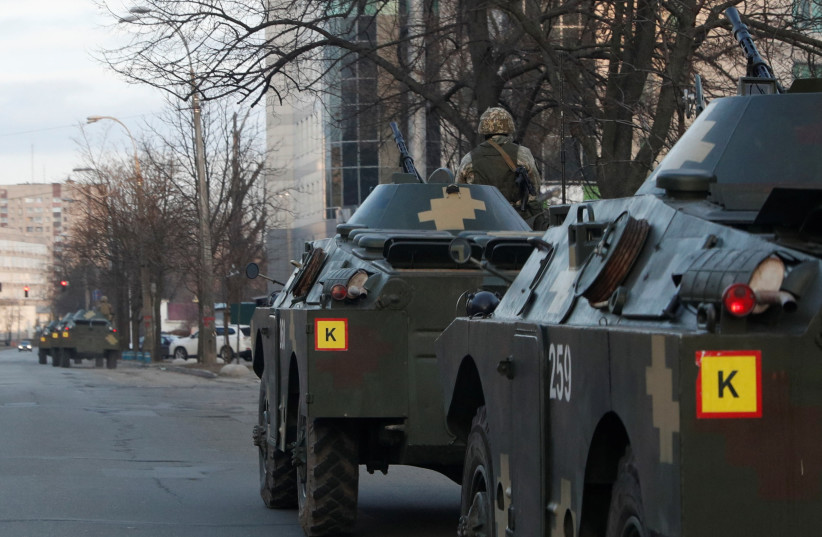The third day of war in Ukraine opened with a video purporting to show a missile had struck a large apartment building, reports of fighting in the capital city and videos of aircraft flying over Ukraine.
Like much of this war, the claims and reports are hard to verify. Both sides have put out inaccurate statements and videos online sometimes have proven to be completely false, such as videos showing a video game, not footage from the war.
What is clear is that Russia has tried to insert forces rapidly into many parts of Ukraine, attacking along a number of axes. They tried to reach Kyiv, along a road of some 150km, by attacking airfields nearby and rushing toward the capital. They have also tried to take Kharkiv and Sumy in eastern Ukraine. They have also pushed out from Crimea with the goal of striking toward Odessa. By Saturday morning, there were even reports of clashes near Lviv, in western Ukraine.
This kind of chaos appears to have been unleashed by a Russia that believed using overwhelming force exploiting its power in the air could lead to Ukrainian collapse. They believed that Ukraine’s main forces were in the east, on the Donbas frontline facing the two separatist areas of Donetsk and Luhansk. The goal was to pin the slow-moving Ukrainian army in the east, leaving it there, while Russia grabbed key cities and strategic airfields.
This, in a sense, was similar to the German invasion of France in 1940, except using airborne assault units deep behind the lines. Videos have shown Russian helicopters ferrying troops and attacking, and other reports have mentioned large Russian aircraft trying to fly into Ukraine, such as IL-76 transport aircraft.

One problem facing coverage of this is that, at the end of the day, we don’t know what we don’t know.
We don’t know why Ukrainian forces were not deployed to blunt the Russian advance at the border north of Kyiv. We don’t know why more bridges were not mined and blown up to prevent the Russian advance. We don’t know what intelligence the Ukrainians received from Russian allies about the Russians trying to grab their airfields, such as Vasylkiv airfield and Hostomel airfield.
The evidence seems to point to an attempt by Russia to grab airfields all around Kyiv, north and south, to bring in troops to surround the capital and cut it off, handing Ukraine a fait accompli and get a surrender or compromise. Russia wants talks with Ukraine but it wants Ukraine to lay down its arms first.
The goal is to totally demoralize and break Ukraine’s resistance by decapitating the leadership and its strategic forces. For that reason, Russia reportedly also targeted key airfields such as Starokonstintinov, Myrhorod, Kulbakino and others. A Ukraine without an air force will have a hard time moving its slower-moving units around and its command and control will have a hard time coordinating a defense.
In Ukraine’s favor may be the fact that the country isn’t trying to rely on a hi-tech war to defeat the Russians. It is handing out small arms to citizens and counting on its units to resist independently in various sectors. Without evidence that this is the plan, this appears to be at least what is happening in places like Kherson.
Day 2 brought reports of Ukraine’s president Volodymyr Zelensky speaking to the people from Kyiv, vowing to stay in the city. His speeches seem to be via a smartphone.
This isn’t like a traditional war.
He’s not surrounded by generals, but rather in the streets. This is a new kind of conflict without comparison to conflicts like the US invasion of Iraq in 2003 or the US-led war on Yugoslavia in 1999.
The complex nature of this war is such that we are seeing something unfold that is very different from other conflicts. Russia’s war on Georgia in 2008 or its intervention in Ukraine in 2014 and in Syria in 2015 were very different. Russia is fighting a unique kind of war on Ukraine.
There is a sense that every day Ukraine holds out, its chances get better. This is because the EU, NATO and others are seeking to find ways to stand by Ukraine. Dozens of countries want to send defensive weapons or other aid. Reports say that the Netherlands will send 200 Stinger missiles, for instance. More is on the way from other states apparently. Ukraine is not alone. But it needs to hold out. Some are making comparisons of the Ukrainian leadership to the Afghan leadership and noting how brave they are to hold out in Kyiv, unlike the Afghan leadership that fled.
But this is setting a low bar. Ukraine’s leadership should stay in the capital and they had ample time to prepare to resist. They have had seven years to rebuild the army from the chaos of 2014 when Ukraine last clashes with Russia and Russia-backed separatists.
Furthermore, Ukraine has fought a war in the Donbas for years. Ukraine needed to be better prepared, but it has also been starved of modern air defense and other needs because western countries were slow to let Ukraine procure the right weapons. This put Ukraine in a difficult position. Russia pretended that Ukraine might one day be a threat to Moscow, but Moscow’s plan for the war reveals that Russia believed Ukraine would be a pushover.
